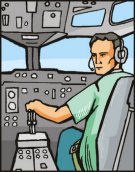
Worksheets and No Prep Teaching Resources
Reading Comprehension Worksheets
Transportation

Transportation
 Worksheets and No Prep Teaching Resources Reading Comprehension Worksheets Transportation |
 Transportation |
| edHelper's suggested reading level: | grades 5 to 7 | |
| Flesch-Kincaid grade level: | 9.25 |
|
Air Navigation, Part 2
By Trista L. Pollard |

|
 1 Did you know that instruments can fly? Don't worry. You won't see clarinets and saxophones landing on runways at airports around the world. What you will see in airplanes and other aircraft are cockpits filled with special instruments that help pilots with air navigation. In Air Navigation, Part 1, we discussed how airplanes and other aircraft maneuver through our skies. In this article we will look at the instruments and devices that keep our pilots and our skies safe.
1 Did you know that instruments can fly? Don't worry. You won't see clarinets and saxophones landing on runways at airports around the world. What you will see in airplanes and other aircraft are cockpits filled with special instruments that help pilots with air navigation. In Air Navigation, Part 1, we discussed how airplanes and other aircraft maneuver through our skies. In this article we will look at the instruments and devices that keep our pilots and our skies safe. |
Create Weekly Reading Books
Prepare for an entire week at once! |
| Leave your feedback on Air Navigation, Part 2 (use this link if you found an error in the story) |
 |
Transportation
|